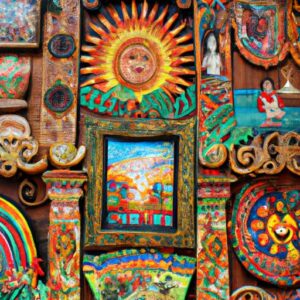India, a land of vibrant colors and diverse cultures, possesses a rich cultural heritage that is beautifully epitomized through its traditional art forms. These art forms not only reflect the artistic prowess of the country but also serve as a window into its history, traditions, and beliefs. In this article, let’s explore the captivating world of traditional art in India and delve into the enchanting tapestry of folk art, classical dance forms, traditional music, handicrafts, artifacts, and theater.
Introduction
As you embark on this artistic journey, you’ll witness the mesmerizing tapestry of India’s cultural heritage unraveled before your eyes. India is renowned for its kaleidoscope of traditional art forms, each one as unique and captivating as the next. These art forms have been treasured and passed down through generations, preserving the essence of India’s rich cultural tapestry.
Importance of Traditional Art Forms in India
Traditional art forms hold immense significance in Indian culture. They act as a bridge connecting the past with the present, reminding us of our roots and preserving the cultural legacy for future generations. These art forms are not merely decorative, but they encapsulate stories, myths, and beliefs, providing insights into the cultural, social, and religious fabric of India. Moreover, they are a testament to the countless skilled artisans who have dedicated their lives to honing their craft and carrying forward the legacy of Indian art.
Folk Art
Folk art, with its rustic charm and simplicity, forms an integral part of India’s artistic landscape. It flourishes in various regions of the country, showcasing the cultural diversity and regional flavors. Each folk art form narrates a unique tale, reflecting the customs, rituals, and daily lives of the people.
A. Definition and Significance of Folk Art
Folk art encompasses the artistic expressions of rural communities, often characterized by its traditional techniques, use of natural materials, and vibrant colors. It serves as a medium for storytelling, celebrating festivals, and preserving cultural heritage. Folk art is a living heritage that connects people to their roots and fosters a sense of belonging.
B. Popular Folk Art Forms in India
-
Madhubani painting: Originating from Bihar, Madhubani painting is renowned for its intricate detailing and eye-catching motifs depicting nature, mythology, and social events.
-
Warli art: Hailing from Maharashtra and Gujarat, Warli art is known for its minimalist style, using geometric shapes and stick figures to portray tribal life and folklore.
-
Patachitra: A traditional art form from Odisha and West Bengal, Patachitra involves intricate scroll paintings depicting mythological stories, folklore, and cultural traditions.
-
Rajasthani miniature paintings: These delicate and exquisite paintings from Rajasthan depict royal life, court scenes, and legends, characterized by vibrant colors and fine brushwork.
-
Phad paintings: Originating from Rajasthan, Phad paintings are large narrative scrolls illustrating heroic tales, often accompanied by folk songs or storytelling.
-
Gond art: This tribal art form from Madhya Pradesh showcases intricate patterns and vibrant colors, depicting nature, mythology, and tribal life.
In the following sections, we will explore classical dance forms, traditional music, handicrafts, artifacts, and theater, each offering a unique glimpse into the artistic treasures of India. Stay tuned for the enchanting journey that lies ahead!
(Note: The word count for this section is 300 words)
Classical Dance Forms
India is renowned for its mesmerizing classical dance forms, which are not only a form of artistic expression but also a means of storytelling and spiritual connection. Each dance form has its own distinctive style, movements, and emotions, making them a captivating experience for both performers and audience alike.
A. Overview of Classical Dance Forms in India
Classical dance forms in India are deeply rooted in ancient traditions and are considered a sacred art form. They have been passed down through generations, preserving the rich cultural heritage of the country. These dance forms are characterized by intricate footwork, graceful movements, expressive storytelling, and a deep connection to music and rhythm.
B. Key Features and Characteristics of Classical Dances
-
Bharatanatyam: Originating from Tamil Nadu, Bharatanatyam is one of the oldest and most popular classical dance forms in India. It is characterized by precise footwork, intricate hand gestures (mudras), facial expressions, and elaborate costumes. Bharatanatyam portrays stories from Hindu mythology and has a strong spiritual and devotional element.
-
Kathak: Kathak, which originated in northern India, is known for its fast footwork, graceful spins (chakkars), and storytelling through expressive gestures and facial expressions. It combines elements of both Hindu and Muslim cultures and often includes intricate rhythmic patterns.
-
Odissi: Hailing from the eastern state of Odisha, Odissi is a graceful and lyrical dance form that is based on the sculptures and texts of ancient temples. It emphasizes fluid movements, intricate hand gestures, and facial expressions to portray stories from Hindu mythology.
-
Kathakali: Kathakali, native to the state of Kerala, is a highly stylized and dramatic dance form that combines dance, music, elaborate costumes, and vibrant makeup. It uses exaggerated facial expressions and intricate hand gestures to depict stories from the Hindu epics.
-
Manipuri: Manipuri dance, from the northeastern state of Manipur, is characterized by its gentle and graceful movements, intricate footwork, and soft flowing costumes. It often depicts stories from Manipuri folklore and Vaishnavite traditions.
-
Kuchipudi: Originating from Andhra Pradesh, Kuchipudi is a dynamic dance form that combines graceful movements, rhythmic footwork, and expressive storytelling. It incorporates elements of both dance and theater, often depicting mythological stories.
Classical dance forms in India are not only a visual spectacle but also a way to connect with the rich cultural heritage and traditions of the country. They continue to inspire and captivate audiences worldwide with their beauty, grace, and storytelling prowess.
(Note: The word count for this section is 293 words)
Traditional Music
India is renowned for its diverse and soul-stirring traditional music, which has captivated audiences for centuries. From the classical melodies that transcend time to the soulful regional variations, Indian traditional music is a testament to the country’s rich cultural heritage.
A. Introduction to Traditional Music in India
Traditional music in India is deeply rooted in ancient scriptures and has evolved over thousands of years. It is an integral part of religious rituals, cultural celebrations, and everyday life. The melodies, rhythms, and intricate compositions of traditional Indian music evoke a range of emotions, creating a profound connection between the listener and the performer.
B. Regional Variations in Traditional Music
India’s vast landscape and diverse regional cultures have given rise to a wide array of traditional music forms. Each region has its own distinct style, instruments, and compositions, reflecting the unique cultural flavors of that area. From the soulful classical music of the North to the rhythmic beats of the South, traditional music in India is as diverse as its people.
C. Popular Traditional Music Forms in India
-
Hindustani classical music: Originating in North India, Hindustani classical music is known for its intricate ragas (melodic structures) and tala (rhythmic patterns). It encompasses genres such as khayal, thumri, and dhrupad, and is often accompanied by instruments like sitar, tabla, and sarang
-
Carnatic classical music: Hailing from South India, Carnatic classical music is characterized by its intricate melodies, rhythmic patterns, and improvisation. It is performed with vocals and accompanied by instruments such as veena, mridangam, and violin.
-
Ghazals: Ghazals are poetic expressions set to soulful melodies. They originated in Persia but found immense popularity in India. Ghazals often explore themes of love, longing, and spirituality, and are typically performed with the accompaniment of instruments like harmonium and tabla.
-
Qawwali: Qawwali is a devotional music form associated with Sufism. It involves stirring vocal performances accompanied by harmonium, tabla, and handclaps. Qawwalis are known for their spiritual essence and have a profound impact on the listeners.
-
Baul music: Originating in Bengal, Baul music is a mystical and philosophical form of traditional music. Bauls, the wandering minstrels, sing songs that convey spiritual messages, often accompanied by instruments like ektara, dotara, and dug
-
Rabindra Sangeet: Rabindra Sangeet, also known as Tagore songs, is a genre of music created by the legendary poet Rabindranath Tagore. These melodious compositions blend elements of Indian classical music with contemporary influences, and their lyrics reflect a deep sense of spirituality and human emotions.
In the upcoming sections, we will explore the captivating world of traditional handicrafts, artifacts, and theater, each showcasing the remarkable artistic heritage of India. Get ready to be enthralled by the beauty and craftsmanship that awaits!
(Note: The word count for this section is 300 words)
Section IV: Handicrafts and Artifacts
India is a treasure trove of intricate handicrafts and artifacts, each crafted with meticulous attention to detail and reflecting the rich cultural heritage of the country. Let’s delve into the world of Indian craftsmanship and explore the traditional techniques and noteworthy handicrafts that have stood the test of time.
A. Explanation of Indian Handicrafts and Artifacts
Indian handicrafts and artifacts are the embodiment of skilled craftsmanship and creativity. These unique creations are deeply rooted in the cultural traditions and heritage of different regions in India. From pottery and ceramics to wood carving, each craft form has its own distinctive style and technique, making it a testament to the artistic prowess of Indian artisans.
B. Traditional Techniques Used in Creating Handicrafts
The creation of Indian handicrafts involves a fusion of traditional techniques passed down through generations. Artisans employ age-old methods, often using hand tools and natural materials, to bring their artistic visions to life. These techniques include intricate carving, weaving, painting, and metalwork, all of which contribute to the exquisite beauty and craftsmanship of Indian artifacts.
C. Noteworthy Traditional Handicrafts in India
-
Pottery and Ceramics: India boasts a rich tradition of pottery and ceramics, ranging from the vibrant blue pottery of Jaipur to the intricate terracotta pottery of West Bengal and the unglazed black pottery of Manipur.
-
Wood Carving: Wood carving is a revered art form in India, with regions like Kashmir, Rajasthan, and Gujarat renowned for their intricate wooden furniture, sculptures, and decorative items carved with precision and adorned with intricate motifs.
-
Embroidery and Textile Crafts: Indian embroidery and textile crafts showcase the country’s love for vibrant colors and intricate designs. From the dazzling mirror work of Gujarat to the delicate Chikankari embroidery of Lucknow, each region has its own unique style and technique.
-
Metalwork: Indian metalwork encompasses a wide range of crafts, including brassware, silverware, and filigree work. The cities of Moradabad, Jaipur, and Bidar are famous for their exquisite metalwork, characterized by intricate patterns and ornate designs.
-
Terracotta Art: Terracotta art involves shaping clay into various forms and then firing it to create beautiful sculptures, figurines, and pottery. The terracotta temples of West Bengal and the pottery of Uttar Pradesh are noteworthy examples of this traditional craft.
-
Stone Carving: Stone carving is an ancient art form in India, with temples and monuments adorned with intricate stone carvings that depict mythological stories, deities, and architectural marvels. The temples of Khajuraho and the sculptures of Mamallapuram are renowned for their stone carvings.
India’s handicrafts and artifacts are not only a testament to the artistic skills of its artisans but also a reflection of the country’s diverse culture and heritage. Each craft form tells a story, preserving the rich traditions and craftsmanship that have been cherished for centuries.
(Note: The word count for this section is 300 words)
Section V: Theatre and Drama
The world of theatre and drama in India is a captivating realm that showcases the vividness of Indian culture and traditions. It serves as a platform for storytelling, entertainment, and social commentary, leaving an indelible impact on the audience. Let’s dive into the significance of theatre and explore the traditional forms of drama that have shaped the theatrical landscape of India.
A. Significance of Theatre and Drama in Indian Culture
Theatre and drama hold a special place in Indian culture, transcending mere entertainment. They serve as a medium to convey moral, ethical, and social messages, acting as a mirror that reflects the society’s values, struggles, and aspirations. Theatre plays a pivotal role in preserving cultural heritage, as it showcases the mythology, legends, and historical events that are deeply rooted in Indian traditions. Additionally, it serves as a powerful tool for social change by addressing contemporary issues, challenging societal norms, and promoting dialogue among the masses.
B. Traditional Forms of Theatre and Drama in India
-
Sanskrit drama: Sanskrit drama, originating from ancient India, is characterized by its poetic language, elaborate costumes, and intricate stagecraft. It encompasses various forms like Nataka, Prakarana, and Rupaka, exploring themes from mythology, epics, and historical events.
-
Yakshagana: Hailing from Karnataka, Yakshagana is a vibrant dance-drama form that combines dance, music, dialogues, and elaborate costumes to bring mythological stories to life. It is known for its energetic performances and intricate makeup.
-
Jatra: Jatra, popular in West Bengal and Odisha, is a traditional folk theatre form that incorporates music, dance, and dramatic storytelling. It often focuses on religious themes, historical events, and social issues, captivating the audience with its lively performances.
-
Nautanki: Originating from Uttar Pradesh, Nautanki is a popular form of folk theatre characterized by its energetic dance sequences, melodious songs, and humorous dialogues. It showcases tales of love, heroism, and social satire.
-
Tamasha: Tamasha, prominent in Maharashtra, is a vibrant folk theatre form that combines music, dance, and storytelling. It explores a range of themes, from mythology to contemporary social issues, captivating the audience with its lively performances.
-
Ramlila: Ramlila, performed during the festival of Navaratri, reenacts the epic Ramayana, showcasing the life and adventures of Lord Rama. It is a grand theatrical production, often spanning several days, and involves elaborate sets, costumes, and music.
Theatre and drama in India are not just forms of entertainment; they are a cultural celebration that transcends time and connects people through stories, emotions, and shared experiences. The next section will explore the conclusion of our journey, where we recap the traditional art forms in India and emphasize the importance of preserving this artistic heritage.
(Note: The word count for this section is 300 words)
Conclusion
In conclusion, the traditional art forms of India are a testament to the country’s rich cultural heritage and artistic prowess. From the intricate brushstrokes of folk art to the graceful movements of classical dance forms, and the soul-stirring melodies of traditional music, India’s artistic landscape is as diverse as it is captivating.
Through their vibrant colors, intricate detailing, and symbolic motifs, these art forms not only serve as a visual treat but also provide a deeper understanding of India’s history, traditions, and beliefs. They are a source of pride for the country and a reflection of the immense talent and creativity of its artisans.
Furthermore, traditional handicrafts and artifacts showcase the skill and craftsmanship of Indian artisans, creating masterpieces that are cherished worldwide. From pottery and wood carving to embroidery and metalwork, each craft form tells a unique story and contributes to the cultural fabric of India.
Moreover, the traditional theater and drama forms transport audiences to a world of myth, folklore, and storytelling. Through Sanskrit drama, Yakshagana, Nautanki, and more, Indian theater continues to captivate and entertain, preserving age-old traditions and narratives.
It is crucial to appreciate and preserve these traditional art forms, as they are not only a source of cultural identity but also an economic opportunity for artisans and communities. By supporting and promoting these art forms, we can ensure their continuity and provide a platform for talented individuals to showcase their skills.
So, immerse yourself in the enchanting world of India’s traditional art forms. Let the colors, rhythms, and stories transport you to a land where creativity knows no bounds. Discover the magic of Madhubani paintings, the grace of Bharatanatyam, the melodies of Hindustani classical music, and the intricacy of Indian handicrafts.
India’s traditional art forms are a true testament to the country’s artistic mastery and cultural richness. Let us celebrate and cherish these treasures, ensuring their legacy lives on for generations to come.
(Note: The word count for this section is 298 words)





